|
||||||
|
Fylgja and Valkyrie
Features of Fylgja and Fate
Spiritual creatures are ephemeral due their immaterial nature. This holds good for the strange being that is named fylgja (pl. fylgjur) or hamingja/ur in Northern Mythology. As we lack Old English terms we may stick with this name.
Whether fylgjur, dises, nornsor valkyries, they are “Fates, who direct a man’s destiny from birth to death” and who are present – unnoticed – at the birth of a child. (pp. 104) They all are shape-changers, their human appearance is but one of their manifestations in which they may choose to reveal themselves to their protégées in a dream. But it is more likely that they cross his path as bird or beast. Valkyries prefer to fly away as swans (Völundarkviða), and due to that they are also known as ”swan maidens”. This, by the way, seems to be most closely related to their nature, and is symbolized by the rune Eventually, the Fylgja or Valkyrie develops a more intense relation with her protégée so that she – having brought predestined death over him – visits him in his grave to revive him with that potent drink, alu,2 and to join him in love. As Woden’s daughter she will take him to Valhalla, cares for him and remains at his side as his eternal partner in ”love and war.” All the above may be derived from inscriptions, rock drawings, and Eddic poetry, though only in fragmentary form. However, all these facets blend into one coherent story, if we turn to the pictures on the Franks Casket, which depicts a royal hero’s desirable course of life in a sequence of emblematic pictures. If they are meant to influence the fate of the king-to-be, they definitely can’t do so without the Fylgja. Present at the Cradle
Seemingly our carver follows the Syrian-Oriental picture formula, where Virgin and Child are depicted on the right side facing the viewer rather than the visitors. They, the Magi, approach the throne from the left, in fixed order of precedence and postures3, humbly offering their presents – just as sub-kings would pay their due tribute. Pictures of this type invariably show an angel between throne and visitors. He is not there as guide to the travellers, but as the courtly master of ceremonies, who makes sure that the company sticks to the rules and pays due respect to etiquette. But while our carver otherwise faithfully renders each detail of the original, even the pattern of the footstool by the throne, he now places a goose or swan where the angel ought to be! This, though, is no ignorant misinterpretation of a winged person, but represents a very deliberate change of the formula. The Woden- knot (O.N. valknut) over the back of the last Magus in line should warn us, symbolically changing the priest of Mithras into an adherent of Woden. So Germanic may hold the clue for the nature of this strange bird.
For the Fates, Thus our rune-master has made use of a Christian emblem (just as pagans had always tended to join what they could not beat), only changing it in a few essentials. This way he procures a noble descent, due homage, proper tribute and, above all, the help of a guardian-companion. Helper at Distress
Immediately left of this holy scene the carver has placed a picture of the cruel revenge taken by the mythical smith Weland on his oppressor, Niðhad. The juxtaposition of Christian love and bloody vengeance, however, is not as contradictory as it seems.
Apart from gifts and wealth there is one other element both pictures have in common: the presence of the Fylgja. Here she is his helper, supplying the beer, Weland needs to seduce his oppressor’s daughter while her brother lies beheaded under the anvil. Thus released by his spouse’s help the elfish smith is able to change his shape and to fly away as a bird.
According to the Vœlundarkviða there were three brothers, Vœlund, Egil und Slagfið, partners of three swan maidens for exactly seven years, before they took off to work at war. One of these was Olrun, whose name proclaims her to be acquainted with the “secrets of beer”. Perhaps it is she who here comes to free Weland
It took a woman, of her knowledge, a Fylgja, to free him. He – unlike other mortals – may have seen her in her human shape when she was around. Companion at War
The life of a warrior-king is determined by fight. As soon as he leaves his realm, which may not be ore than his estate, he rides in enemy territory. According to the „Rune Poem“ the rune [
The Roman twins, according to the legend, were fed by the she-wolf; a consort is not known off. To make sure hat Woden is appropriately represented in this scene on the casket the carver adds a second wolf, thus changing the lupa into that Old Norse wolfish pair Geri and Freki. The scene is no longer the grotto by the Tiber, and there is no shepherd trying to scare the she-wolf away. Now it is the Holy Grove of the Germanic peoples, and here we have four warriors devoutly kneeling, and each of them holding the stem of a tree which tells his lot. We should expect the Fylgja somewhere here. As she normally does not show herself in her human shape, she has likely adopted that of the wolf, Woden’s follower. And as ” Woden’s girl” she is the warrior’s following spirit in wolf-form, thus equipping him with the attributes of the god. Donor of Victory
And so he depicts four scenes of the conquest of Jerusalem in Chooser on the Battlefield …
As all the other pictures refer to certain episode in history or mythology, this one will be part of a lost Germanic saga. In the moment of death the hero encounters his Fylgja or Valkyrie, which the carver has composed from all her different shapes (e.g. bird, horse, snake, man). This creature holds a twig, which seems to tell his doom (by means of twig runes).
… and Guide to Valhalla
The horse by the grave is no ordinary animal. There are two ”Woden-knots”, (valknutr), between its legs, very similar to images on the Swedish standing stones of the Viking era. May be this alludes to Odin’s eight-legged stallion Sleipnir; at least it indicates a sacred scene. This way the carver has procured a death befitting his high standing. In order to make sure that this sinister event was not premature, he encoded the text very thoroughly. It may not have worked properly, as some ignorant knife tried to erase the word for ill luck (aglac). Heroes in Heaven With these four panels, the warrior’s life on Earth has run its course from life to death. But death does not mean the end. Actually, real life begins here in the realm and at the side of the gods. Quite reasonably the lid offers a glimpse of what the Christians regard as Heaven and the Pagans knew as Asgard: the site where Woden gathered his troop of slain heroes, to defend creation against the frost giants in the final battle, Ragnarök. 6
The Vœlundarkviða (Poetic Edda) introduces Egil as Weland’s brother, and like him he is the partner of a swan maiden.. Whether or not they were seen as brothers as early as the 7th century is uncertain, never the less he will have belonged to the sphere of ‘lower mythology’, i.e. between the human beings and their gods. 8 And like Weland on the front panel, he – if this is a female – would have his Fylgja at his side, helping him.
Picture: "Silver hanger in shape of a Valkyrie", Köping Klinta, States Historiska Museum.
Annotations: 1 Golther, Handbuch der germanischen Mythologie, S. 98ff 2 This word (O.N. œl, ‘ale’) which we find on urns, probably as a wish for the dead one on his way to Valhalla,froze to a formula, so to speak. It did not change when it migrated to England, as it was of runic and numeric power, the way it was. More on that in The World of Icons, Runes, Numbers and Values There are amulets, too, which show the Valkyrie with a 'drenchorn', and similar depictions on the Swedish standing stones with the same motif, where the Valkyrie receives the dead warrior with her drinking horn. 3 Alfred Becker, Franks Casket; Zu den Bildern und Inschriften des Runenkästchens von Auzon (Regensburg, 1972) S. 125 – 134 Zur Ikonographie der Magierbilder 4 Just like in Latin where pecus (cattle, G.Vieh) is the word stem for pecunia (money). 5 Ardre VIII shows just these elements,the smithy (to recognize the topic), the victims (the two beheaded princes and their debauched sister) and the one freed by these deeds, Weland in the shape of a bird. 6 In Norse mythology the valkyries are dísir, minor female deities, who serve Odin. The valkyries' purpose was to choose the most heroic of those who had died in battle and to carry them off to Valhalla where they became einherjar. This was necessary because Odin needed warriors to fight at his side at the preordained battle at the end of the world, Ragnarök. In Valhalla the valkyries also “serve drink and look after the tableware and drinking vessels” (Prose Edda Gylfaginning 35). It appears, however, that there was no clear distinction between the valkyries and the norns. Skuld is for instance both a valkyrie and a norn, and in the Darraðarljóð (lines 1-52), the valkyries weave the web of war (see below). According to the Prose Edda (Gylfaginning 35), “Odin sends [the valkyries] to every battle. They allot death to men and govern victory. Gunn and Rota [two valkyries] and the youngest norn, called Skuld, always ride to choose who shall be slain and to govern the killings”. (Source: Wikipedia) 7 In Norse mythology, Yggdrasil (Old Norse Yggdrasill, the extra -l is a nominative case marker) is the World Tree, a great ash tree located at the center of the universe and joining the nine worlds of Norse cosmology. The trunk of the tree may be thought of as forming a vertical axis around which these worlds are situated, with Ásgard, realm of the gods, at the top and the Hel, located in Niflheim, at the bottom. Midgard, or Mid-Earth the world of mortals, is located in the middle and surrounded by Jötunheim, land of giants, both of which are separated by the ocean. Yggdrasil is also sometimes known as Mimameid or Laerad. (Source: Wikipedia) 8 See Zur Wielandsage mit einem PDF Anhang aus Becker, Franks Casket. A shorter English version in The development of the Weland Saga Tradition 9 In Norse mythology, Hliðskjálf (sometimes Anglicized Hlidskjalf; English: "high-gate"[1]) is the high seat of Odin enabling him to see into all worlds. In Grímnismál, Odin and Frigg are both sitting in Hlidskjálf when they see their foster sons Agnar and Geirröd, one living in a cave with a giantess and the other a king. Frigg then made the accusation to her husband that Geirröd was miserly and inhospitable toward guests, so after wagering with one another over the veracity of the statement Odin set out to visit Geirröd in order to settle the matter. In Skírnismál, it is Freyr who sits in Hlidskjálf when he looks into Jötunheim and sees the beautiful giant maiden Gerd, with whom he instantly falls in love. (Source: Wikipedia)
|
||||||
|
||||||
|

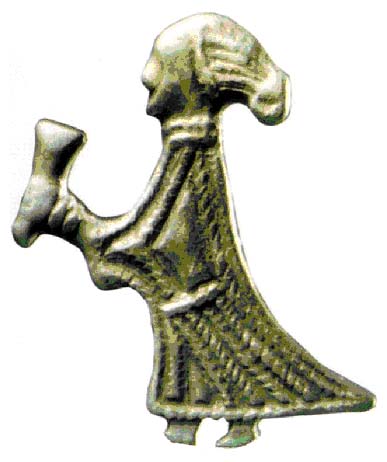 Golther
Golther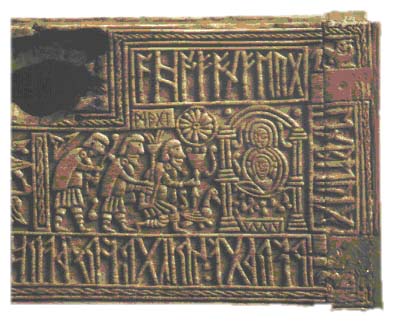 All lives start with birth, and a king-to-be is no exception. It is the setting, which matters, and therefore the proper emblem needs to be employed. For a pagan rune-master it was no problem to appropriate the already-familiar mythology and symbolism of Christianity. The Birth of Christ, though, was less likely chosen for the Saviour Himself than for the Magi, who fascinated the people both by their skills and their wealth, as expressed by the gifts they bring. In order to invoke their help the carver inscribes their picture with the word
All lives start with birth, and a king-to-be is no exception. It is the setting, which matters, and therefore the proper emblem needs to be employed. For a pagan rune-master it was no problem to appropriate the already-familiar mythology and symbolism of Christianity. The Birth of Christ, though, was less likely chosen for the Saviour Himself than for the Magi, who fascinated the people both by their skills and their wealth, as expressed by the gifts they bring. In order to invoke their help the carver inscribes their picture with the word 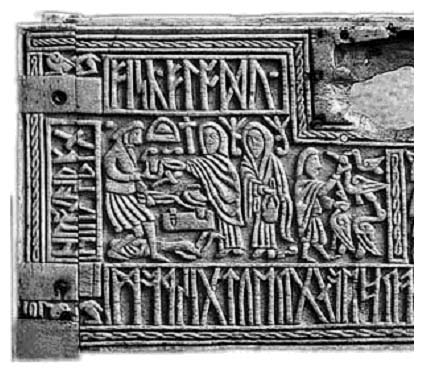

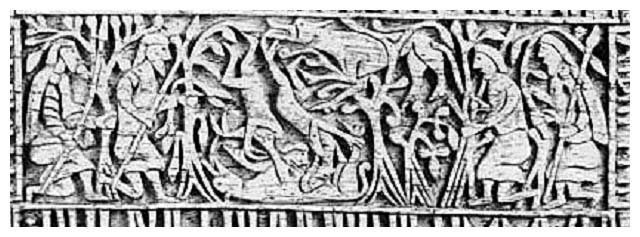
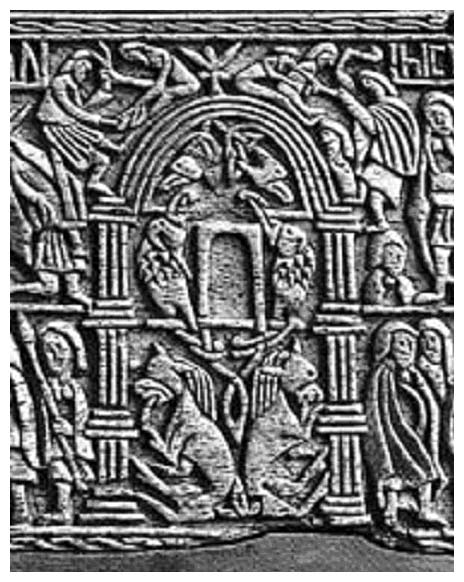 A campaign so well prepared must be crowned by a glorious victory, which demands all the virtues of the king: reward for the brave retainers and punishment for traitors and cowards. Victory and justice are closely linked. All that contains the rune [
A campaign so well prepared must be crowned by a glorious victory, which demands all the virtues of the king: reward for the brave retainers and punishment for traitors and cowards. Victory and justice are closely linked. All that contains the rune [ The hero may now enjoy the peak of power and glory, but there is a price to pay or goal to gain, depending on the point of view. If he does not want to enter Hel instead of Valhalla, he must die a warrior’s death. In battle, not in bed. It is not the enemy, who defeats him, however, but his own Fylgja, now his Valkyrie (battle chooser), who
The hero may now enjoy the peak of power and glory, but there is a price to pay or goal to gain, depending on the point of view. If he does not want to enter Hel instead of Valhalla, he must die a warrior’s death. In battle, not in bed. It is not the enemy, who defeats him, however, but his own Fylgja, now his Valkyrie (battle chooser), who 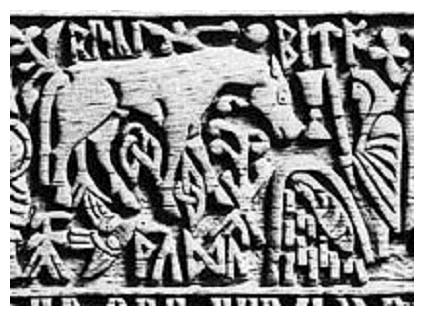 Thus the twig turns into the fatal weapon, a trait we know from other tales. Now that her warrior has been killed the Fylgja changes into a bird and flies from her decreed place, Harmberg, to the grave of the deceased. There we see her in her human shape, the lethal spear in her hand. A chalice in front of her may contain the potent drink of alu, ‘beer’ these days.
Thus the twig turns into the fatal weapon, a trait we know from other tales. Now that her warrior has been killed the Fylgja changes into a bird and flies from her decreed place, Harmberg, to the grave of the deceased. There we see her in her human shape, the lethal spear in her hand. A chalice in front of her may contain the potent drink of alu, ‘beer’ these days.  Aesir, when his hour has come. With the famous archer Egil he finds a figure, suited in every respect. He chooses ‘Æ’ as the proper initial vowel and for numeric reasons adds an ‘I’ at the end. The archer by the name
Aesir, when his hour has come. With the famous archer Egil he finds a figure, suited in every respect. He chooses ‘Æ’ as the proper initial vowel and for numeric reasons adds an ‘I’ at the end. The archer by the name 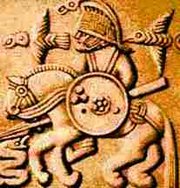
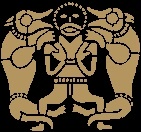 So the person under the arc could be her, but if we compare this construction to the “Throne of the Virgin” we may wonder whether or not this is the
So the person under the arc could be her, but if we compare this construction to the “Throne of the Virgin” we may wonder whether or not this is the 


